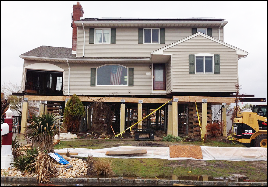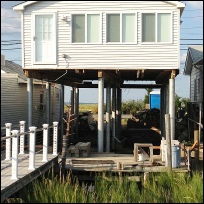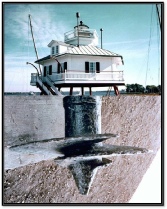

Copyright © 2011-24 Helical Pile World, LLC. All Rights Reserved.
Home | Engineers | Manufacturers | Installation Contractors | News | Technical Advisors | Contact Us







Use of Helicals Above Grade in Saltwater Environments
by Pat Haffert
Danbro Vice President
August, 2022



A now-retired engineer once told me that helicals were not intended to be used above grade or in water, especially saltwater. The exception to the rule was low-rise walkways and, he pointed out, they may require batter piles and some sacrificial steel on the piles. My counter-argument was Mitchell’s lighthouses, but I was reminded that those helicals were not the slender, extendable helicals of our day. Later, this gentleman was part of the team that developed the grouted helical micropile and that changed everything.
When I present our PDH seminars to geotechnical engineers, it is not unusual to get corrosion questions. As a key design consideration, it is covered in the presentation, but I still get the “Yeah, okay. But what about this situation?” Corrosion can be a big deal on some projects, and I always have examples to illustrate what was done to compensate. Before grout, there were special coatings, but usually sacrificial steel was the answer. As the Cox Creek project for Delmarva Power illustrates, sacrificial steel can still be an answer. The RS 4500.337 pile was overkill for the 70-kip tension load, but it will take quite a while to rust out. In a case like this, the manufacturer’s contribution is also key as the hot-dipped galvanization process used by IDEAL will further extend the life of the pile. Click here to read Cox Creek Case History
As I pointed out in last month’s article, the grouted helical micropile, sleeved with either PVC or steel, isolates the steel from aggressive soils, as well as water, and protects from corrosion and decay. Many of our installing contractors were involved in supplying foundations for raising houses post Super Storm Sandy and worked on or near coastlines. Many of these structures are supported above grade, out of the flood zone, on grouted helicals. As the accompanying photos illustrate, the sleeve and grout stiffen the pile, allowing it to function without surrounding soil, but also provide corrosion protection as well.
Helicals have long been used above grade, in saltwater environments, for pedestrian walkways. How far above grade together with the capacity required determine if batter piles are necessary. Sometimes, we upgraded to a higher capacity pile, not  for the load, but for additional sacrificial steel. Post Sandy, we had to revisit one of our first major helical projects (1997), a walkway for PSE&G in the salt marshes of New Jersey. Click here to read Maurice River Case History The power company decided to replace the damaged boardwalk. First, to aid in the planning for phase II, an examination took place to determine how the helicals performed during the storm. From the examination, we gleaned some valuable information. The storm waters demolished the deck planking. The helicals, however, in tension during the lashing storm surge, held firm with little movement. The original square shaft supporting the walkway and elevation platforms also exhibited no corrosion whatsoever. Granted, it was only 15 years of life, but it was in a tidal area susceptible to frequent storms. It was no surprise when PSE&G decided to rebuild, using higher capacity piles and PermaTrak decking to better withstand Mother Nature. Click Here to Read PSE&G Basket Flats Environmental Boardwalk Case History
for the load, but for additional sacrificial steel. Post Sandy, we had to revisit one of our first major helical projects (1997), a walkway for PSE&G in the salt marshes of New Jersey. Click here to read Maurice River Case History The power company decided to replace the damaged boardwalk. First, to aid in the planning for phase II, an examination took place to determine how the helicals performed during the storm. From the examination, we gleaned some valuable information. The storm waters demolished the deck planking. The helicals, however, in tension during the lashing storm surge, held firm with little movement. The original square shaft supporting the walkway and elevation platforms also exhibited no corrosion whatsoever. Granted, it was only 15 years of life, but it was in a tidal area susceptible to frequent storms. It was no surprise when PSE&G decided to rebuild, using higher capacity piles and PermaTrak decking to better withstand Mother Nature. Click Here to Read PSE&G Basket Flats Environmental Boardwalk Case History
DFI has a wonderful library covering a variety of deep foundation products, including helicals, with studies and research papers on topics of interest or concern. There are several scholarly papers on the reaction of steel products, such as helicals in given soil conditions. Depending on soil conditions, helicals are estimated to last 75 to 150 years in ground. The modern incarnation of helicals has only been around since 1912. Their origins , however, go back to 1836 and their early use was almost exclusively in water. Perhaps a look back will help us to better understand the future. In 1867, helicals were used to support the Hooper Strait Lighthouse in the Chesapeake Bay. In 1877, the super structure was swept away in an ice storm, but the foundation remained intact; the lighthouse was rebuilt and put back into service in 1879. In 1969, the lighthouse was decommissioned and moved to Saint Michaels, MD, to the Chesapeake Bay Maritime Museum. One of the original screw piles (24 inches in diameter) was retrieved to examine its condition and to include it as part of the exhibit at the museum. Sitting on a pedestal under the elevated Lighthouse, with exposure to air and the elements, the cast-iron helical has started to show signs of corrosion. However, when it was extracted from the mud of the Chesapeake Bay in 1966, it was like the day it was installed: one hundred years in soft bay mud and not a speck of rust! Click here to read about the Hooper Strait Lighthouse
, however, go back to 1836 and their early use was almost exclusively in water. Perhaps a look back will help us to better understand the future. In 1867, helicals were used to support the Hooper Strait Lighthouse in the Chesapeake Bay. In 1877, the super structure was swept away in an ice storm, but the foundation remained intact; the lighthouse was rebuilt and put back into service in 1879. In 1969, the lighthouse was decommissioned and moved to Saint Michaels, MD, to the Chesapeake Bay Maritime Museum. One of the original screw piles (24 inches in diameter) was retrieved to examine its condition and to include it as part of the exhibit at the museum. Sitting on a pedestal under the elevated Lighthouse, with exposure to air and the elements, the cast-iron helical has started to show signs of corrosion. However, when it was extracted from the mud of the Chesapeake Bay in 1966, it was like the day it was installed: one hundred years in soft bay mud and not a speck of rust! Click here to read about the Hooper Strait Lighthouse
The history of helicals above grade is yet unwritten, but with successful practices such as additional coatings, sacrificial steel, and sleeved, grouted piles, there is no reason to doubt that some of these projects will land in the Helical Hall of Fame, along with the Hooper Strait Lighthouse, in the Longevity Wing!